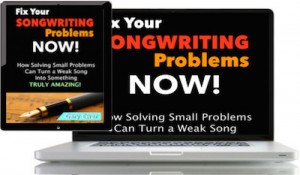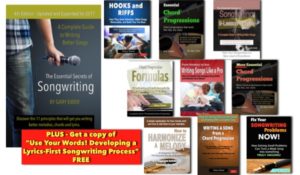For most songs, an intro serves at least three purposes:
- Establish the key of the verse (or sometimes the chorus, if that’s different).
- Establish the tempo and rhythmic feel.
- Establish the mood.
Almost any song in the pop genres that you can name will do those three things. But occasionally you’ll come across songs that sit in a key other than the verse they lead into (“Strawberry Fields Forever” – Lennon & McCartney), set up a different tempo and/or feel (“Roundabout” – Yes), or establish a different mood (“Does Anybody Really Know What Time It Is” – Robert Lamm).
 Time to fix what’s ailing your songs. Read “Fix Your Songwriting Problems – NOW!” – It’s part of “The Essential Secrets of Songwriting 10-eBook Bundle” – Or get it separately.
Time to fix what’s ailing your songs. Read “Fix Your Songwriting Problems – NOW!” – It’s part of “The Essential Secrets of Songwriting 10-eBook Bundle” – Or get it separately.
In a way, the intro for “Roundabout” eventually gets around to setting up the tempo and feel of the song. But the main intro is the kind of thing that usually gets cut when creating a radio single version.
One particularly strange intro that’s worth taking a closer look at is The Doors’ “Light My Fire“, and it’s the chord progression that’s the creative bit. The song appears in various pressings in different keys, so I’ve put the chords in the key of A:
INTRO: G – D – F – Bb – Eb – Ab – A||VERSE 1: Am – F#m
When you look at it, the first thing you notice is that it doesn’t settle into any particular key easily, the apparent tonic chord changing as it goes through a kind of circle of fourths/fifths to wind up on the chord A major.
From that A major, your ears are expecting to hear either D major or D minor as the key for that first verse. But no, it abruptly modulates to the key of A minor for the start of the verse.
But even there, A minor is the key only because it’s the first chord of the verse. It’s followed by F#m, which is not a chord we find in A minor.
And more oddities: it’s not unusual for a song with a minor key verse to switch to the relative major for the chorus. If your verse is in the key of A minor, the most common shift would be to C major. But in “Light My Fire”, the switch is to D major.
What Does An Odd Intro Do For a Song?
It’s difficult to say why this strange intro works. Personally, I find several things captivating about it:
- The fourths/fifths chord circle, along with the instrumentation (reminiscent of a keyboard-based Baroque-era composition).
- The ending of the intro on A major with the abrupt transition to A minor.
- The rhythmic ideas (eighth-two sixteenths motif, mainly) which never really get used in the main part of the song.
With so many odd changes, why does it work so well? I think the main reason for it working is the fact that each small section is captivating all on its own. That intro could almost be the intro for any song. The verse, placed relatively high in the singer’s range, seems to beg for an even higher chorus, but the chorus relaxes down into the lower range (until the final chorus repeats).
If the job of a songwriter is to capture the listeners’ interest as quickly as possible, this intro fits the bill. It also shows us that despite the fact that most intros will establish key and feel, it doesn’t need to be that way.
For your own songs, “Light My Fire” shows that you can, in fact, grab attention by offering things not normally offered by intros. Where the most creative parts of songs are usually melodies and lyrics starting with the verse, it is possible to make the intro stand out and demand a bit of attention. It certainly beats the basic guitar-strumming intro that you might have been considering.
 Written by Gary Ewer. Follow Gary on Twitter.
Written by Gary Ewer. Follow Gary on Twitter.
 The perfect combination: “The Essential Secrets of Songwriting 10-eBook Bundle” and a Study Guide! Dig into the songwriting manuals that thousands of songwriters are using to polish their technique, complete with a study guide to show you how to progress through the materials. Comes with an 11th FREE ebook: “Use Your Words! Developing a Lyrics-First Songwriting Process.”
The perfect combination: “The Essential Secrets of Songwriting 10-eBook Bundle” and a Study Guide! Dig into the songwriting manuals that thousands of songwriters are using to polish their technique, complete with a study guide to show you how to progress through the materials. Comes with an 11th FREE ebook: “Use Your Words! Developing a Lyrics-First Songwriting Process.”











I love your analysis of songs, of songwriting, Gary. I am more a player of chord instruments, (piano and guitar), than a songwriter but these analyses help me in improvising with a jazz fakebook.
Thank you for your work to bring these ideas to us!